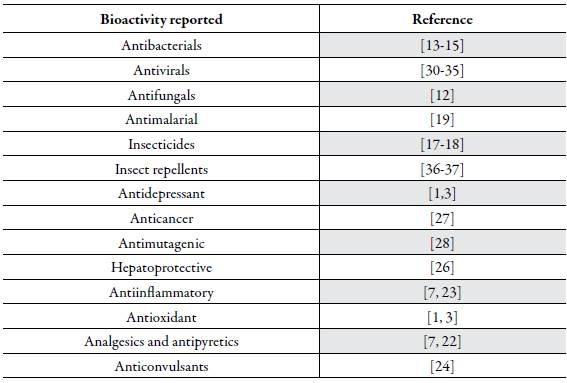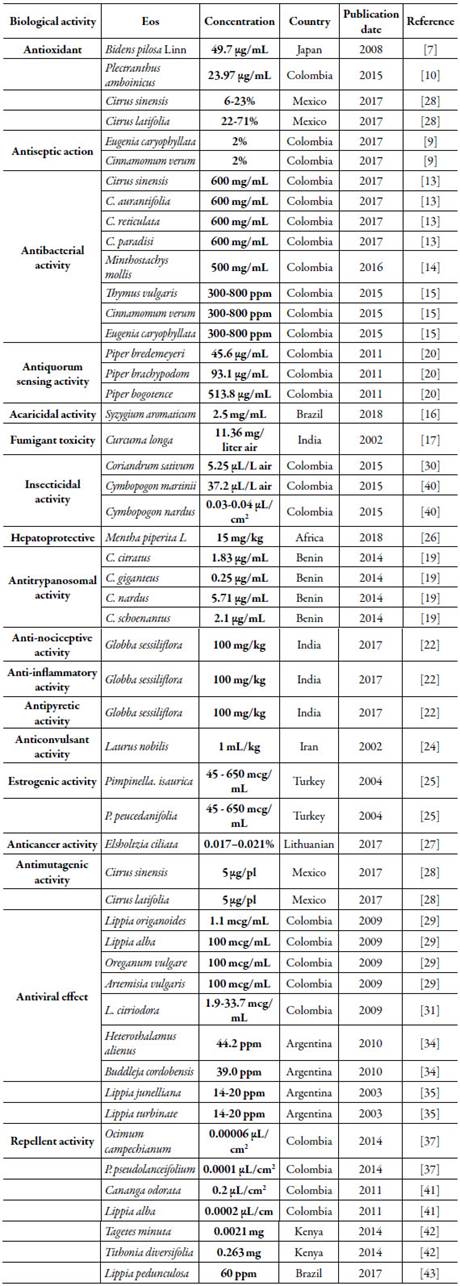INTRODUCTION
Essential oils (EOs) are complex mixtures of volatile organic compounds produced in the form of secondary metabolites in plants that can contain about 20-60 components in very different concentrations [1,2]. They are characterized because they contain two or three main components in relatively high concentrations (20-70%) compared to other components present in minimal amounts [3]. They may consist of monoterpenes, sesquiterpenes, and phenylpropanes, which may contain different functional groups (alkanes, alcohols, aldehydes, ketones, esters and acids) [1,2].
In nature, EOs plays an important role in the protection of plants such as antibacterial, antiviral, antifungal, insecticide and also against herbivores, reducing their appetite for these plants. They are also responsible for the characteristic smell of plants, which can attract some insects to favor the dispersal of pollen and seeds, or repel other undesirable ones [3]. Around 3000 of the essential oils are known and 10% of them having commercial importance in the cosmetic, food and pharmaceutical industries, and in agriculture [3,4]. Therefore, they are generally recognized as safe by the FDA (Food and Drug Administration). Its composition can vary considerably between species of aromatic plants and varieties and within the same variety of different geographical areas [1].
METHODOLOGY
An exhaustive search was carried out in PubMed, Scopus, Google scholar and SciELO databases to find an article that related the different biological activities of essential oils and their components. The search was conducted until January 2018. A text-mining step was carried out in order to detect citation-associated relationships between essential oils and several biological activities. Taking into account the dates of publication and the country of origin.
These keywords were recognized through literature reviews using a wide variety of academic databases and search engines available online, such as GoPubmed (http://gopubmed.org/web/gopubmed/), pubGraph (http://datamining.cs.ucla.edu/cgi-bin/pubgraph.cgi), and Helioblast (http://helioblast.heliotext.com/) and the analysis of associations among these terms was done in the PubMed/Medline literature database was carried out using the Jaccard co-occurrence score, as a measure of the degree to which the two queries coincide among all publications. The information obtained was organized in order to identify the reported biological activity, the essential oil responsible for the activity and the biologically active concentration.
RESULTS
Bioactivity of essential oils
The EOs has a wide application in pharmacology (see figure 1), especially for their antimicrobial properties [5, 6], the hydrocarbon and oxygenated monoterpenes are able to destroy the cellular integrity and therefore inhibit respiration and transport of ions [7]. The terpenes; Pine, myrcene, limonene, Ocimene, linalool, and verbenum are related to the antimicrobial activity of the essential oil of Bidens pilosa [7]. Essential oils with an abundance of phenylpropanoids and phenols inhibit platelet aggregation. The α-terpineol has cytotoxic properties, D-limonene, anticancer in male rats [1], perillic alcohol used in the treatment of different types of cancer, which is found in Phase I and II clinical studies [8], antiseptic, anti-inflammatory, antioxidant, antifungal, anti-depressant, aphrodisiac and other properties present in a greater or lesser degree in all oils [1,3,9,10]. They are also used for their relaxing or stimulating effects on the Central Nervous System, bronchial, urinary infections and those caused by cuts and burns [3, 11].
Many studies carried out with essential oils have reported that they have a broad microbiological activity such as: antifungal [12], antibacterial [13-15], acaricide [16], insecticide [17,18], antimalarial [19], quorum sensing [20], and antiviral [21]. They also have properties such as: analgesics [7], antipyretics [22], anti-inflammatories [7,23], anticonvulsants [24], as an estrogenic agent [25], hepatoprotective [26], anticancer [27] and antimutagenic [28]. They are also used in the treatment of gastric ulcer and different types of cancer [3].
The EOs has shown antiviral activity against species of the Flavivirus genus. In fact, it has been shown that the EOs of Lippia origanoides, Oreganum vulgare, Lippia alba and Artemisia vulgaris have an antiviral effect against the yellow fever virus [29]. Nowadays, there are reports of the antiviral activity of essential oils against the dengue virus. Authors such as Pájaro-Castro et al. [30], Ocazionez et al. [31], Meneses et al. [32], Meneses et al. [33], Duschatzky et al. [34] and García et al. [35] has revealed the antiviral properties of these natural products. In the field of agriculture, EOs have been recognized for their repellent activity [36, 37], insecticide and fumigant [38-40]. Neiro et al., [1] reported more than 80 different essential oils families with repellent activity for arthropod species.
Taking into account that essential oils are complex mixtures of many molecules, it is important to establish if the biological activities identified in them are due to a single component or several of them, that is, if their biological effects are the result of a synergy of all the molecules or if they reflect only the main molecules present at the highest levels according to the gas chromatography analysis [1,2]. The studies found in the literature generally do not answer this question. In general, it is found that the main components reflect fairly well the biological characteristics of the essential oils from which they were isolated, and their effects depend only on their concentration when each component is analyzed independently or in some cases of the mixture. Therefore, it is possible that the activity of the main components is modulated by other molecules that are in lower concentration in the essential oil. In that sense, for biological purposes, it is more informative to study a complete essential oil instead of some of its components because the concept of synergy seems to be more significant [3].
In the search carried out using the keyword essential oils, 73814 articles were observed until 2018. An increase in the number of public articles was observed, being 929 in the year 1994, this value has been increased every year until 5853 in the year 2017 and 1524 until January 2018. The journals that have most published articles related to essential oils are: Food Chemistry (1746), Journal of Chromatography A. (1350), Industrial Crops and Products (1307) and Phytochemistry (1159).
When the search was carried out using the keywords essential oils and biological activity, 27.021 articles published up to 2018 were found, as well as an increase in the number of publications each year, being 319 for the year 1994 and 2656 for the year 2017, being 713 publications so far in 2018. Table 1 shows some of the essential oils with their concentrations reported with some biological activity worldwide. Taking into account the Jaccard co-occurrence e (-1.0), there is a clear association between the essential oils and the different biological activities reported. The main journals that have published an article with these two key words were: Food Chemistry (643), Industrial Crops and Products (625), Journal of Ethnopharmacology (549), Journal of Chromatography A (434), Food and Chemical Toxicology (375) and Phytochemistry (326).
General considerations
According to the bibliographic search carried out, essential oils are an important and rich source of bioactive molecules, which can be used in different fields of pharmaceutical sciences. In fact, many of these studies are focused on evaluating the phytochemical profile of a particular essential oil. The main biological activity attributable to essential oils is the antioxidant activity with 17846 reports (24.2%) until January 2018. In these studies, this activity has been reported in more than 100 essential oils from different plant species.
The second biological activity that has been most reported for essential oils is the antimicrobial activity with 8815 (11.9%), followed by insecticidal and repellent activity with 7827 (10.6%), and the least reported activities are anticancer, estrogen, hepatoprotective, anticonvulsant, antimutagenic, antiviral, antipyretic, acaricide, antinoceptive, antitripanosomal, anti-inflammatory activity, from major to minor.
The above indicates the great potential of essential oils as sources of bioactive molecules, however it is important to consider the complex chemical composition of these natural products, and the interaction of these to have a certain activity. So, the mechanism of action of essential oils is difficult to understand and in some cases is not completely elucidated. In fact, it has been reported that some essential oils have a synergistic effect [44-49]. An example of this is the use of essential oils in the development of biopesticides with different mechanisms of action and that often exhibit mutual synergistic relationships, which can be effective in preventing the development of populations of pathogens and resistant pests. However, it is important to establish relationships between individual substances in EOs and the effects of sublethal concentrations in white and non-white organisms [50]. In addition, essential oils are very useful, although it is a challenge to identify if a certain action is by individual components or by mixtures of them, as well as to elucidate their mechanism of action.

















